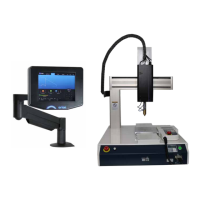47
for metals, consumables, coatings, cleaners, and degreasers.
• Do not weld in locations near degreasing, cleaning, or spraying operations. The heat and rays of the
weld can react with vapors to form highly toxic and irritating gases.
• Do not weld on coated metals, such as galvanized, lead, or cadmium-plated steel, unless the
coating is removed from the weld area, the work area is well ventilated, and the operator is wearing
an air-supplied respirator. The coatings and any metals containing these elements can give off
toxic fumes if welded.
SAFETY PRECAUTIONS FOR FALLING EQUIPMENT
•
Use a working surface of adequate physical strength to support the welding unit
during operation or storage.
• Secure welding unit during transport so that it cannot tip or fall.
MAGNETIC FIELDS CAN AFFECT IMPLANTED MEDICAL DEVICES
•
Wearers of pacemakers and other implanted medical devices should keep away.
• Implanted medical device wearers should consult their doctor and the device
manufacturer before going near arc welding, spot welding, gouging, plasma arc
cutting, or induction heating operations.
OVERUSE CAN CAUSE OVERHEATING
•
Allow a cooling period between strenuous welding schedules; follow rated duty
cycle.
• If overheating occurs often, reduce duty cycle before starting to weld again.
Principal Safety Standards
Safety in Welding, Cutting, and Allied Processes, ANSI Standard Z49.1,from Global Engineering Documents
(phone: 1-877-413-5184, website:www.global.ihs.com).
OSHA, Occupational Safety and Health Standards for General Industry, Title 29, Code of Federal
Regulations (CFR), Part 1910, Subpart Q, and Part 1926, Subpart J, from U.S. Government Printing Office,

